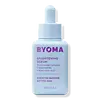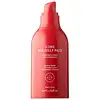What's inside
What's inside
 Key Ingredients
Key Ingredients

 Benefits
Benefits

 Concerns
Concerns

 Ingredients Side-by-side
Ingredients Side-by-side

Water
Skin ConditioningMethylpropanediol
SolventNiacinamide
Smoothing1,2-Hexanediol
Skin ConditioningGlycerin
HumectantPolyglyceryl-10 Laurate
Skin ConditioningSodium Hyaluronate
HumectantCeramide NP
Skin ConditioningCholesterol
EmollientCaprylic/Capric Triglyceride
MaskingPhytosphingosine
Skin ConditioningSodium Phytate
Ascorbic Acid
AntioxidantStearic Acid
CleansingOleic Acid
EmollientHydrogenated Lecithin
EmulsifyingEthylhexylglycerin
Skin ConditioningXanthan Gum
EmulsifyingSqualane
EmollientTocopherol
AntioxidantLactic Acid
BufferingCarbomer
Emulsion StabilisingTromethamine
BufferingCaprylyl Glycol
EmollientCaprylhydroxamic Acid
Water, Methylpropanediol, Niacinamide, 1,2-Hexanediol, Glycerin, Polyglyceryl-10 Laurate, Sodium Hyaluronate, Ceramide NP, Cholesterol, Caprylic/Capric Triglyceride, Phytosphingosine, Sodium Phytate, Ascorbic Acid, Stearic Acid, Oleic Acid, Hydrogenated Lecithin, Ethylhexylglycerin, Xanthan Gum, Squalane, Tocopherol, Lactic Acid, Carbomer, Tromethamine, Caprylyl Glycol, Caprylhydroxamic Acid
Water
Skin ConditioningButylene Glycol
HumectantGlycerin
HumectantNiacinamide
SmoothingPEG-150 Distearate
EmulsifyingPolysorbate 80
EmulsifyingPentylene Glycol
Skin ConditioningChondrus Crispus Extract
Skin ConditioningSaccharum Officinarum Extract
MoisturisingSea Water
HumectantEclipta Prostrata Extract
Skin ConditioningHydrolyzed Collagen
EmollientMelia Azadirachta Leaf Extract
Skin ConditioningHibiscus Sabdariffa Flower Extract
Skin ConditioningMoringa Oleifera Seed Oil
EmollientCamellia Japonica Flower Extract
EmollientCarica Papaya Fruit Extract
Skin ConditioningPancratium Maritimum Extract
BleachingHaematococcus Pluvialis Extract
AntioxidantPEG-240/Hdi Copolymer Bis-Decyltetradeceth-20 Ether
StabilisingCaprylyl Glycol
EmollientOctyldodeceth-16
EmulsifyingPEG-60 Hydrogenated Castor Oil
EmulsifyingAminomethyl Propanol
BufferingAdenosine
Skin ConditioningHydrolyzed Hyaluronic Acid
HumectantPropanediol
SolventCaprylic/Capric Triglyceride
MaskingSodium Hyaluronate Crosspolymer
HumectantHydrolyzed Glycosaminoglycans
HumectantDisodium Adenosine Triphosphate
Skin Conditioning1,2-Hexanediol
Skin ConditioningSodium Hyaluronate
HumectantLecithin
EmollientPolyglutamic Acid
Skin ConditioningSaccharide Isomerate
HumectantBenzyl Glycol
SolventAlgin
MaskingCeramide NP
Skin ConditioningCreatine
Skin ConditioningPotassium Laurate
EmulsifyingSodium Hydroxide
BufferingCholesterol
EmollientOleic Acid
EmollientEthylhexylglycerin
Skin ConditioningSodium Ascorbyl Phosphate
AntioxidantAstaxanthin
Skin ConditioningHyaluronic Acid
HumectantRaspberry Ketone
MaskingCyanocobalamin
Skin ConditioningCarbomer
Emulsion StabilisingBHT
AntioxidantDisodium EDTA
Phenoxyethanol
PreservativeParfum
MaskingWater, Butylene Glycol, Glycerin, Niacinamide, PEG-150 Distearate, Polysorbate 80, Pentylene Glycol, Chondrus Crispus Extract, Saccharum Officinarum Extract, Sea Water, Eclipta Prostrata Extract, Hydrolyzed Collagen, Melia Azadirachta Leaf Extract, Hibiscus Sabdariffa Flower Extract, Moringa Oleifera Seed Oil, Camellia Japonica Flower Extract, Carica Papaya Fruit Extract, Pancratium Maritimum Extract, Haematococcus Pluvialis Extract, PEG-240/Hdi Copolymer Bis-Decyltetradeceth-20 Ether, Caprylyl Glycol, Octyldodeceth-16, PEG-60 Hydrogenated Castor Oil, Aminomethyl Propanol, Adenosine, Hydrolyzed Hyaluronic Acid, Propanediol, Caprylic/Capric Triglyceride, Sodium Hyaluronate Crosspolymer, Hydrolyzed Glycosaminoglycans, Disodium Adenosine Triphosphate, 1,2-Hexanediol, Sodium Hyaluronate, Lecithin, Polyglutamic Acid, Saccharide Isomerate, Benzyl Glycol, Algin, Ceramide NP, Creatine, Potassium Laurate, Sodium Hydroxide, Cholesterol, Oleic Acid, Ethylhexylglycerin, Sodium Ascorbyl Phosphate, Astaxanthin, Hyaluronic Acid, Raspberry Ketone, Cyanocobalamin, Carbomer, BHT, Disodium EDTA, Phenoxyethanol, Parfum
 Reviews
Reviews

Ingredients Explained
These ingredients are found in both products.
Ingredients higher up in an ingredient list are typically present in a larger amount.
1,2-Hexanediol is a synthetic liquid and another multi-functional powerhouse.
It is a:
- Humectant, drawing moisture into the skin
- Emollient, helping to soften skin
- Solvent, dispersing and stabilizing formulas
- Preservative booster, enhancing the antimicrobial activity of other preservatives
This ingredient is an emollient, solvent, and texture enhancer. It is considered a skin-softener by helping the skin prevent moisture loss.
It helps thicken a product's formula and makes it easier to spread by dissolving clumping compounds.
Caprylic Triglyceride is made by combining glycerin with coconut oil, forming a clear liquid.
While there is an assumption Caprylic Triglyceride can clog pores due to it being derived from coconut oil, there is no research supporting this.
Learn more about Caprylic/Capric TriglycerideCaprylyl Glycol is a humectant and emollient, meaning it attracts and preserves moisture.
It is a common ingredient in many products, especially those designed to hydrate skin. The primary benefits are retaining moisture, skin softening, and promoting a healthy skin barrier.
Though Caprylyl Glycol is an alcohol derived from fatty acids, it is not the kind that can dry out skin.
This ingredient is also used as a preservative to extend the life of products. It has slight antimicrobial properties.
Learn more about Caprylyl GlycolCarbomer is a polymer of acrylic acid. Its main role is to create a gel consistency.
A high amount of carbomer can cause pilling or balling up of products. Don't worry, most products contain 1% or less of carbomer.
Ceramide NP is a type of ceramide and formally known as ceramide 3.
Ceramides are intercellular lipids naturally found in our skin that bonds dead skin cells together to create a barrier. They are known for their ability to hold water and thus are a great ingredient for dry skin.
Ceramides are an important building block for our skin barrier. A stronger barrier helps the skin look more firm and hydrated. By bolstering the skin ceramides act as a barrier against irritating ingredients. This can help with inflammation as well.
If you would like to eat ceramides, sweet potatoes contain a small amount.
Read more about other common types of ceramides here:
Ceramide AP
Ceramide EOP
Cholesterol is a class of organic molecules called lipids. It helps hydrate your skin and is essential to having a healthy skin barrier.
Our skin naturally contains cholesterol in the outermost layer. Besides cholesterol, it also contains ceramides and fatty acids. Cholesterol makes up about 1/4 of your skin's outer layer and barrier. Your skin barrier is responsible for keeping allergens and microbes out. Having a healthy skin barrier is also responsible for keeping your skin firm and plump.
Our bodies use cholestrol to create vitamin D, steroid hormones, and more.
Learn more about CholesterolEthylhexylglycerin (we can't pronounce this either) is commonly used as a preservative and skin softener. It is derived from glyceryl.
You might see Ethylhexylglycerin often paired with other preservatives such as phenoxyethanol. Ethylhexylglycerin has been found to increase the effectiveness of these other preservatives.
Glycerin is already naturally found in your skin. It helps moisturize and protect your skin.
A study from 2016 found glycerin to be more effective as a humectant than AHAs and hyaluronic acid.
As a humectant, it helps the skin stay hydrated by pulling moisture to your skin. The low molecular weight of glycerin allows it to pull moisture into the deeper layers of your skin.
Hydrated skin improves your skin barrier; Your skin barrier helps protect against irritants and bacteria.
Glycerin has also been found to have antimicrobial and antiviral properties. Due to these properties, glycerin is often used in wound and burn treatments.
In cosmetics, glycerin is usually derived from plants such as soybean or palm. However, it can also be sourced from animals, such as tallow or animal fat.
This ingredient is organic, colorless, odorless, and non-toxic.
Glycerin is the name for this ingredient in American English. British English uses Glycerol/Glycerine.
Learn more about GlycerinNiacinamide is a multitasking form of vitamin B3 that strengthens the skin barrier, reduces pores and dark spots, regulates oil, and improves signs of aging.
And the best part? It's gentle and well-tolerated by most skin types, including sensitive and reactive skin.
You might have heard of "niacin flush", or the reddening of skin that causes itchiness. Niacinamide has not been found to cause this.
In very rare cases, some individuals may not be able to tolerate niacinamide at all or experience an allergic reaction to it.
If you are experiencing flaking, irritation, and dryness with this ingredient, be sure to double check all your products as this ingredient can be found in all categories of skincare.
When incorporating niacinamide into your routine, look out for concentration amounts. Typically, 5% niacinamide provides benefits such as fading dark spots. However, if you have sensitive skin, it is better to begin with a smaller concentration.
When you apply niacinamide to your skin, your body converts it into nicotinamide adenine dinucleotide (NAD). NAD is an essential coenzyme that is already found in your cells as "fuel" and powers countless biological processes.
In your skin, NAD helps repair cell damage, produce new healthy cells, support collagen production, strengthen the skin barrier, and fight environmental stressors (like UV and pollution).
Our natural NAD levels start to decline with age, leading to slower skin repair, visible aging, and a weaker skin barrier. By providing your skin niacinamide, you're recharging your skin's NAD levels. This leads to stronger, healthier, and younger looking skin.
Another name for vitamin B3 is nicotinamide. This vitamin is water-soluble and our bodies don't store it. We obtain Vitamin B3 from either food or skincare. Meat, fish, wheat, yeast, and leafy greens contain vitamin B3.
The type of niacinamide used in skincare is synthetically created.
Learn more about NiacinamideOleic Acid is an Omega-9 fatty acid. It can be found in many plant oils such as avocado and marula oils.
This ingredient is used to enhance the texture of products and as a cleansing agent.
Oleic Acid may not be fungal acne safe.
Learn more about Oleic AcidSodium Hyaluronate is hyaluronic acid's salt form. It is commonly derived from the sodium salt of hyaluronic acid.
Like hyaluronic acid, it is great at holding water and acts as a humectant. This makes it a great skin hydrating ingredient.
Sodium Hyaluronate is naturally occurring in our bodies and is mostly found in eye fluid and joints.
These are some other common types of Hyaluronic Acid:
Learn more about Sodium HyaluronateWater. It's the most common cosmetic ingredient of all. You'll usually see it at the top of ingredient lists, meaning that it makes up the largest part of the product.
So why is it so popular? Water most often acts as a solvent - this means that it helps dissolve other ingredients into the formulation.
You'll also recognize water as that liquid we all need to stay alive. If you see this, drink a glass of water. Stay hydrated!
Learn more about Water